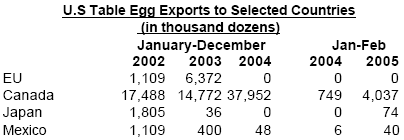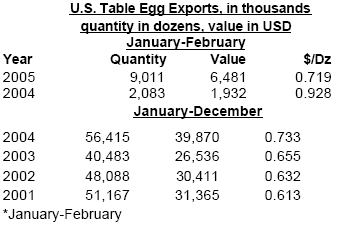



International Egg and Poultry Review
By the USDA's Agricultural Marketing Service - This is a weekly report looking at international developments concerning the poultry industry, this week looking at World egg production and North Korea.
Table Eggs
World egg production reached 57,861,746 metric tons in 2004, up 3%
from the previous year (56,236,075 MT). In the U.S., high producer
returns in late 2003 resulted in a rapid increase in the U.S. layer flock
in 2003-2004. Table egg production in the U.S. reached a record high
of 6,365 milion dozen, 2.2% over 2003. Table egg production in the
U.S. is expected to increase to about 6,456 million eggs, nearly 1.6 %
over 2004.
Bans on U.S. poultry and eggs due to avian influenza
outbreaks reduced U.S. table egg exports to some markets. However,
when the EU experienced an outbreak of highly pathogenic avian influenza
early in 2003, millions of birds were culled and exports of U.S.
table eggs to the EU surged 475%. Once the EU layer flock had recovered,
U.S. table egg exports to the EU plummeted.

Exports to Canada surged in 2004 after avian influenza
was detected in British Columbia. Millions of birds were
culled and the resulting shortage of table eggs led to a
huge increase of table eggs from the U.S.

U.S. table egg exports fell 8% in 2002 and 16% in 2003
before increasing 39% in 2004 due to a strong demand
from Canada. U.S. egg exports are especially sensitive
to supply shifts because only 2% of U.S. egg production
enters the export market.
Source: USDA /FAS U.S. Trade Statistics, National Agricultural
Statistics Service, Economic Research Services; United
NationsFood and Agriculture Organization; International Egg
Commission
Bird Flu Outbreak In North Korea Contained
The recent outbreak of avian influenza in North Korea (DPRK) has
been successfully contained, according to a statement released on
April 25, 2005 by the UN Food and Agriculture Organization. An H7
strain of the bird flu virus, detected on three poultry farms near the
capital Pyongyang, led to the culling of around 218,000 infected chickens.
Birds in unaffected poultry houses were vaccinated. The H7 virus caused
severe disease in chickens, but is not directly related to the H5N1 avian
influenza virus circulating in other parts of Asia.
Source: UN Food and Agriculture Organization
To view the full report, including tables please click here
Source: USDA's Agricultural Marketing Service - 26th April 2005








